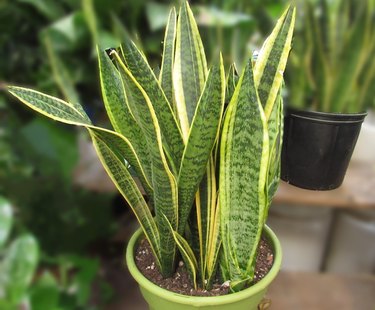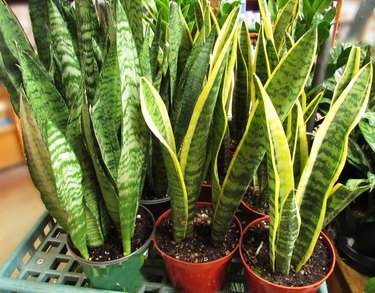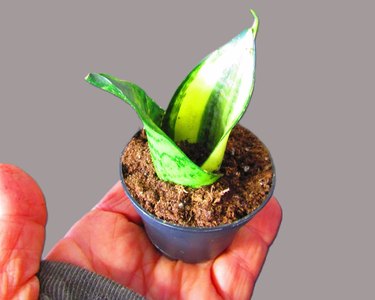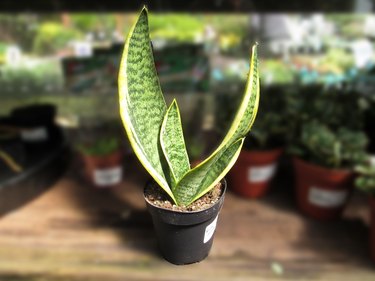

With stiff, upright leaves that look like swords, the snake plant, also called mother-in-law's tongue, has everything going for it other than its common names. In the houseplant universe, it's among the easiest plants to care for, being hardy and drought-tolerant not to mention attractive. It is forgiving enough for beginners, yet given its complex variegation and interesting cultivars, it is sufficiently architectural and exotic to appeal to confirmed houseplant collectors.
Dracaena trifasciata Highlights****
- Easy Care: Yes!
- Light and Location: Shade to bright, indirect light
- Watering: Every few weeks when the soil is dry
- Growth Rate: Slow-growing
- Flowering: Indoor snake plants rarely flower
- Pet-Safe: No! Toxic to dogs and cats
Video of the Day
All About the Snake Plant

If you are new to houseplants, you might be put off by common names like snake plant and "mother-in-law's tongue. I know I was, and I didn't invite one into my house for years. But learn from my mistake and put your feelings about snakes and in-laws aside because this is a houseplant for the ages.
Video of the Day
Do you know this plant as Sansevieria? This was the snake plant's genus for years, but it was recently reclassified by botanists into the genus Dracaena, joining corn plants and lucky bamboo. Snake plants are native to Madagascar, southern Africa, and southern Asia, and they thrive outdoors in USDA zones 9-11. They grow to 12 feet tall or taller outdoors but stay half as tall indoors. They make great houseplants and are reputed to filter the air, removing toxic pollutants and boosting mental health.
With some 70 species and innumerable cultivars, snake plants come in many sizes and with many color variations. The most common species has dark green leaves with yellow borders, but there are popular cultivars available in different shapes and color patterns.
How to Care for Snake Plants

With its elegant, stiff, upright leaves, a snake plant looks almost artificial. But it has all of the same needs as other houseplants, only it's a lot more tolerant. If you pot it correctly and find an appropriate site, your time commitment to snake plant care will be minimal.
Let's review the plant's needs one by one.
Best Location for Snake Plants
Like many common houseplants, snake plants prefer bright, indirect sunlight or sunlight filtered through filmy curtains. While fussy plants will yellow or shed leaves if they don't get what they want, tolerant plants like the snake plant just shrug it off and take what comes. I keep snake plants in my home office, which has one little north-facing window. It has lived there for five years and is going strong.
Potting Soil for Snake Plants

However, snake plants won't compromise when it comes to well-draining soil. Wet soil is one of the only things that can kill off these tough plants, and this usually results from improper drainage. You can find potting soil specifically designed for cacti and/or succulents, and it's a good choice.
Container for Snake Plants
With their unusual upright foliage, snake plants pop in a variety of different container types, but the thing to keep in mind is drainage. Be sure the pot you choose has multiple drainage holes to allow excess water to drain out. Terra cotta pots absorb extra water, so they are ideal.
Temperature for Snake Plants
Snakes like it warm and so do most mothers-in-law, so it's no shock that snake plants prefer temperatures above 50 degrees Fahrenheit. That means you can set your thermometer to a temperature that is comfortable for you, and your snake plant will thrive.
On the other hand, be sure you don't place the container by a heater or air conditioning unit. Fluctuating hot and cold temperatures don't work for houseplants of any species.
Watering Snake Plants
If you are the kind of person who sometimes forgets to water, it's a good idea to select a drought-tolerant succulent like a snake plant. When you water, the plant stores some in those long, flat leaves. That means they have a reserve for times of drought.
But note this: While a weekly or bimonthly watering is great, don't overwater your snake plant. Wet soil is one of the few conditions that will kill this houseplant.
Fertilizing Snake Plants
I never fertilize my snake plants, but some people consider fertilizing to be a houseplant commandment. If this is you, use a balanced fertilizer, dilute it to half strength, and apply it once in spring and once in midsummer.
Monthly Cleaning for Snake Plants

Dusty foliage is not as lovely as clean foliage, so that's reason enough to schedule a monthly "bath" for your houseplants. But it's not just for cosmetic reasons; removing dust from your snake plant leaves helps the plant "breathe."
Moisten a microfiber cloth. Then, gently wipe each side of each leaf. This makes it easier for the plant to photosynthesize.
Types of Snake Plants
Are there more types of snakes or snake plants? Snakes win this comparison hands down, given the 3,000 or more species. But with 70 species and hundreds of cultivars, you won't get bored looking at types of snake plants. Many have leaves like swords in different variegations, but some look more like asparagus or agave than the traditional snake plant. Here are a few to try.

Rounded leaves that grow in a rosette? Yes, this is a snake plant! It is a dwarf cultivar with yellow edging called 'Jade Pagoda'. The variegation plus the leaf shape make this a standout.

The gorgeous snake plant cultivar 'Futura Superba' rarely gets more than five leaves. But the arresting coloration offers a stunning contrast to the simplicity of the leaf structure. It grows a little over a foot tall.

The foliage of the snake plant species Dracaena angolensis looks more like asparagus or cigarillos than swords, earning it the common name cigar snake plant. Its yellow/green variegated leaves grow to 3 feet tall.
How to Propagate Snake Plants
With so many different types of snake plants, you may prefer a varied collection rather than many of the same. But just in case, it's important to know that you can easily propagate a snake plant. The top two ways to do this are by division and rooting cuttings. Both are best undertaken in spring.
Division should only be attempted when the snake plant is over 4 inches tall. To divide a plant, remove it from its container. Use a sharp knife to divide the plant into sections, with some foliage and some roots on each. Replant each section in its own pot with moist succulent potting soil.
For cutting propagation, use garden scissors to remove a healthy leaf at its base. Put the cut end in water in a sunny location. Change the water every week until roots appear. It can take months, so be patient. When substantial roots develop, pot it in moist succulent potting soil.